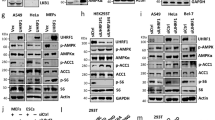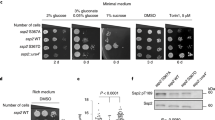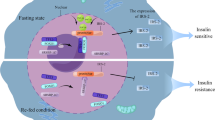Abstract
Transcriptional complexes that contain peroxisome-proliferator-activated receptor coactivator (PGC)-1α control mitochondrial oxidative function to maintain energy homeostasis in response to nutrient and hormonal signals1,2. An important component in the energy and nutrient pathways is mammalian target of rapamycin (mTOR), a kinase that regulates cell growth, size and survival3,4,5. However, it is unknown whether and how mTOR controls mitochondrial oxidative activities. Here we show that mTOR is necessary for the maintenance of mitochondrial oxidative function. In skeletal muscle tissues and cells, the mTOR inhibitor rapamycin decreased the gene expression of the mitochondrial transcriptional regulators PGC-1α, oestrogen-related receptor α and nuclear respiratory factors, resulting in a decrease in mitochondrial gene expression and oxygen consumption. Using computational genomics, we identified the transcription factor yin-yang 1 (YY1) as a common target of mTOR and PGC-1α. Knockdown of YY1 caused a significant decrease in mitochondrial gene expression and in respiration, and YY1 was required for rapamycin-dependent repression of those genes. Moreover, mTOR and raptor interacted with YY1, and inhibition of mTOR resulted in a failure of YY1 to interact with and be coactivated by PGC-1α. We have therefore identified a mechanism by which a nutrient sensor (mTOR) balances energy metabolism by means of the transcriptional control of mitochondrial oxidative function. These results have important implications for our understanding of how these pathways might be altered in metabolic diseases and cancer.
This is a preview of subscription content, access via your institution
Access options
Subscribe to this journal
Receive 51 print issues and online access
$199.00 per year
only $3.90 per issue
Buy this article
- Purchase on Springer Link
- Instant access to full article PDF
Prices may be subject to local taxes which are calculated during checkout




Similar content being viewed by others
References
Finck, B. N. & Kelly, D. P. PGC-1 coactivators: inducible regulators of energy metabolism in health and disease. J. Clin. Invest. 116, 615–622 (2006)
Lin, J., Handschin, C. & Spiegelman, B. M. Metabolic control through the PGC-1 family of transcription coactivators. Cell Metab. 1, 361–370 (2005)
Wullschleger, S., Loewith, R. & Hall, M. N. TOR signaling in growth and metabolism. Cell 124, 471–484 (2006)
Dann, S. G. & Thomas, G. The amino acid sensitive TOR pathway from yeast to mammals. FEBS Lett. 580, 2821–2829 (2006)
Sarbassov, D. D., Ali, S. M. & Sabatini, D. M. Growing roles for the mTOR pathway. Curr. Opin. Cell Biol. 17, 596–603 (2005)
Inoki, K., Li, Y., Xu, T. & Guan, K. L. Rheb GTPase is a direct target of TSC2 GAP activity and regulates mTOR signaling. Genes Dev. 17, 1829–1834 (2003)
Long, X., Lin, Y., Ortiz-Vega, S., Yonezawa, K. & Avruch, J. Rheb binds and regulates the mTOR kinase. Curr. Biol. 15, 702–713 (2005)
Nobukini, T. et al. Amino acids mediate mTOR/raptor signaling through activation of class 3 phosphatidylinositol 3OH-kinase. Proc. Natl Acad. Sci. USA 102, 14238–14243 (2005)
Peng, T., Golub, T. R. & Sabatini, D. M. The immunosuppressant rapamycin mimics a starvation-like signal distinct from amino acid and glucose deprivation. Mol. Cell. Biol. 22, 5575–5584 (2002)
Schieke, S. M. et al. The mammalian target of rapamycin (mTOR) pathway regulates mitochondrial oxygen consumption and oxidative capacity. J. Biol. Chem. 281, 27643–27652 (2006)
Mootha, V. K. et al. Errα and Gabpa/b specify PGC-1α-dependent oxidative phosphorylation gene expression that is altered in diabetic muscle. Proc. Natl Acad. Sci. USA 101, 6570–6575 (2004)
Mootha, V. K. et al. PGC-1α-responsive genes involved in oxidative phosphorylation are coordinately downregulated in human diabetes. Nature Genet. 34, 267–273 (2003)
Patti, M. E. et al. Coordinated reduction of genes of oxidative metabolism in humans with insulin resistance and diabetes: Potential role of PGC1 and NRF1. Proc. Natl Acad. Sci. USA 100, 8466–8471 (2003)
Zhang, H. et al. Loss of Tsc1/Tsc2 activates mTOR and disrupts PI3K–Akt signaling through downregulation of PDGFR. J. Clin. Invest. 112, 1223–1233 (2003)
Shah, O. J., Wang, Z. & Hunter, T. Inappropriate activation of the TSC/Rheb/mTOR/S6K cassette induces IRS1/2 depletion, insulin resistance, and cell survival deficiencies. Curr. Biol. 14, 1650–1656 (2004)
Sarbassov, D. D. et al. Prolonged rapamycin treatment inhibits mTORC2 assembly and Akt/PKB. Mol. Cell 22, 159–168 (2006)
Tusher, V. G., Tibshirani, R. & Chu, G. Significance analysis of microarrays applied to the ionizing radiation response. Proc. Natl Acad. Sci. USA 98, 5116–5121 (2001)
Calvo, S. et al. Systematic identification of human mitochondrial disease genes through integrative genomics. Nature Genet. 38, 576–582 (2006)
Yant, S. R. et al. High affinity YY1 binding motifs: identification of two core types (ACAT and CCAT) and distribution of potential binding sites within the human beta globin cluster. Nucleic Acids Res. 23, 4353–4362 (1995)
Wilkinson, F. H., Park, K. & Atchison, M. L. Polycomb recruitment to DNA in vivo by the YY1 REPO domain. Proc. Natl Acad. Sci. USA 103, 19296–19301 (2006)
Schreiber, S. N. et al. The estrogen-related receptor α (ERRα) functions in PPARγ coactivator 1α (PGC-1α)-induced mitochondrial biogenesis. Proc. Natl Acad. Sci. USA 101, 6472–6477 (2004)
Ribes, D., Kamar, N., Esposito, L. & Rostaing, L. Combined use of tacrolimus and sirolimus in de novo renal transplant patients: current data. Transplant. Proc. 37, 2813–2816 (2005)
Morrisett, J. D. et al. Effects of sirolimus on plasma lipids, lipoprotein levels, and fatty acid metabolism in renal transplant patients. J. Lipid Res. 43, 1170–1180 (2002)
Leone, T. C. et al. PGC-1α deficiency causes multi-system energy metabolic derangements: muscle dysfunction, abnormal weight control and hepatic steatosis. PLoS Biol. 3, e101 (2005)
Saks, V. A. et al. Permeabilized cell and skinned fiber techniques in studies of mitochondrial function in vivo . Mol. Cell. Biochem. 184, 81–100 (1998)
Irizarry, R. A. et al. Summaries of Affymetrix GeneChip probe level data. Nucleic Acids Res. 31, e15 (2003)
Andersson, U. & Scarpulla, R. C. Pgc-1-related coactivator, a novel, serum-inducible coactivator of nuclear respiratory factor 1-dependent transcription in mammalian cells. Mol. Cell. Biol. 21, 3738–3749 (2001)
Pierce, S. B. et al. Regulation of DAF-2 receptor signaling by human insulin and ins-1, a member of the unusually large and diverse C. elegans insulin gene family. Genes Dev. 15, 672–686 (2001)
Kim, D. H. et al. mTOR interacts with raptor to form a nutrient-sensitive complex that signals to the cell growth machinery. Cell 110, 163–175 (2002)
Sancak, Y. et al. PRAS40 is an insulin-regulated inhibitor of the mTORC1 protein kinase. Mol. Cell 25, 903–915 (2007)
Acknowledgements
We thank members of the Puigserver laboratory for helpful comments and discussions on this work; S.-H. Kim for technical assistance; M. Montminy for the anti-PGC-1α polyclonal antibody; D. Kwiatkowski for the TSC2-/- and TSC2+/+ murine embryonic fibroblasts; R. Abraham for the AU1-mTOR expression plasmid; and D. Sabatini for HA–raptor and Myc–rictor expression constructs. These studies were supported by a National Institutes of Health R21 grant (P.P.), a grant from the American Diabetes Association/Smith Family Foundation (V.K.M.) and a Burroughs Wellcome Career Award in the Biomedical Sciences (V.K.M.).
Author information
Authors and Affiliations
Corresponding authors
Supplementary information
Supplementary Information
This file contains Supplementary Figures1-7 with Legends. A referenced Supplementary Methods are also contained as well as a list of oligonucleotide primers used in the text. (PDF 1195 kb)
Supplementary Table 1
This file contains Supplementary Table 1 which is an Excel Spreadsheet of microarray data containing Affymetrix Probe Set ID, gene title, and expression values for 3 vehicle treated samples and 3 rapamycin treated samples. (XLS 8257 kb)
Supplementary Table 2
This file contains Supplementary Table 2 which is an Excel Spreadsheet of microarray data containing Affymetrix Probe Set ID, gene title, and expression values for 3 GFP-infected samples and 3 PGC-1α-infected samples. (XLS 8272 kb)
Rights and permissions
About this article
Cite this article
Cunningham, J., Rodgers, J., Arlow, D. et al. mTOR controls mitochondrial oxidative function through a YY1–PGC-1α transcriptional complex. Nature 450, 736–740 (2007). https://doi.org/10.1038/nature06322
Received:
Accepted:
Published:
Issue Date:
DOI: https://doi.org/10.1038/nature06322
This article is cited by
-
Bioinformatics analysis of the microRNA genes associated with type 2 cardiorenal syndrome
BMC Cardiovascular Disorders (2024)
-
The mitochondrial quality control system: a new target for exercise therapeutic intervention in the treatment of brain insulin resistance-induced neurodegeneration in obesity
International Journal of Obesity (2024)
-
mTORC1 in energy expenditure: consequences for obesity
Nature Reviews Endocrinology (2024)
-
PGC-1α activation boosts exercise-dependent cellular response in the skeletal muscle
Journal of Physiology and Biochemistry (2024)
-
Geroprotector drugs and exercise: friends or foes on healthy longevity?
BMC Biology (2023)
Comments
By submitting a comment you agree to abide by our Terms and Community Guidelines. If you find something abusive or that does not comply with our terms or guidelines please flag it as inappropriate.



